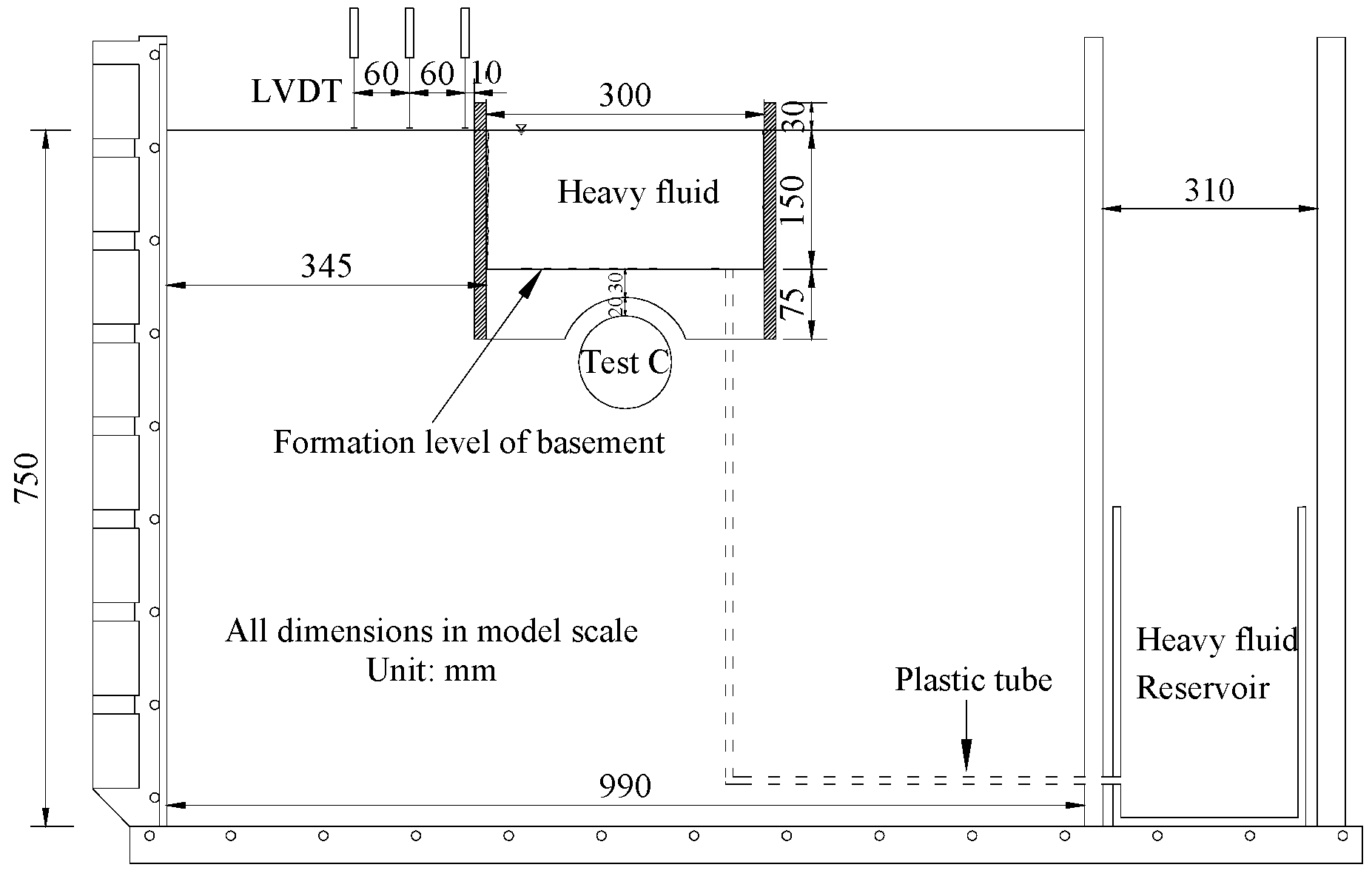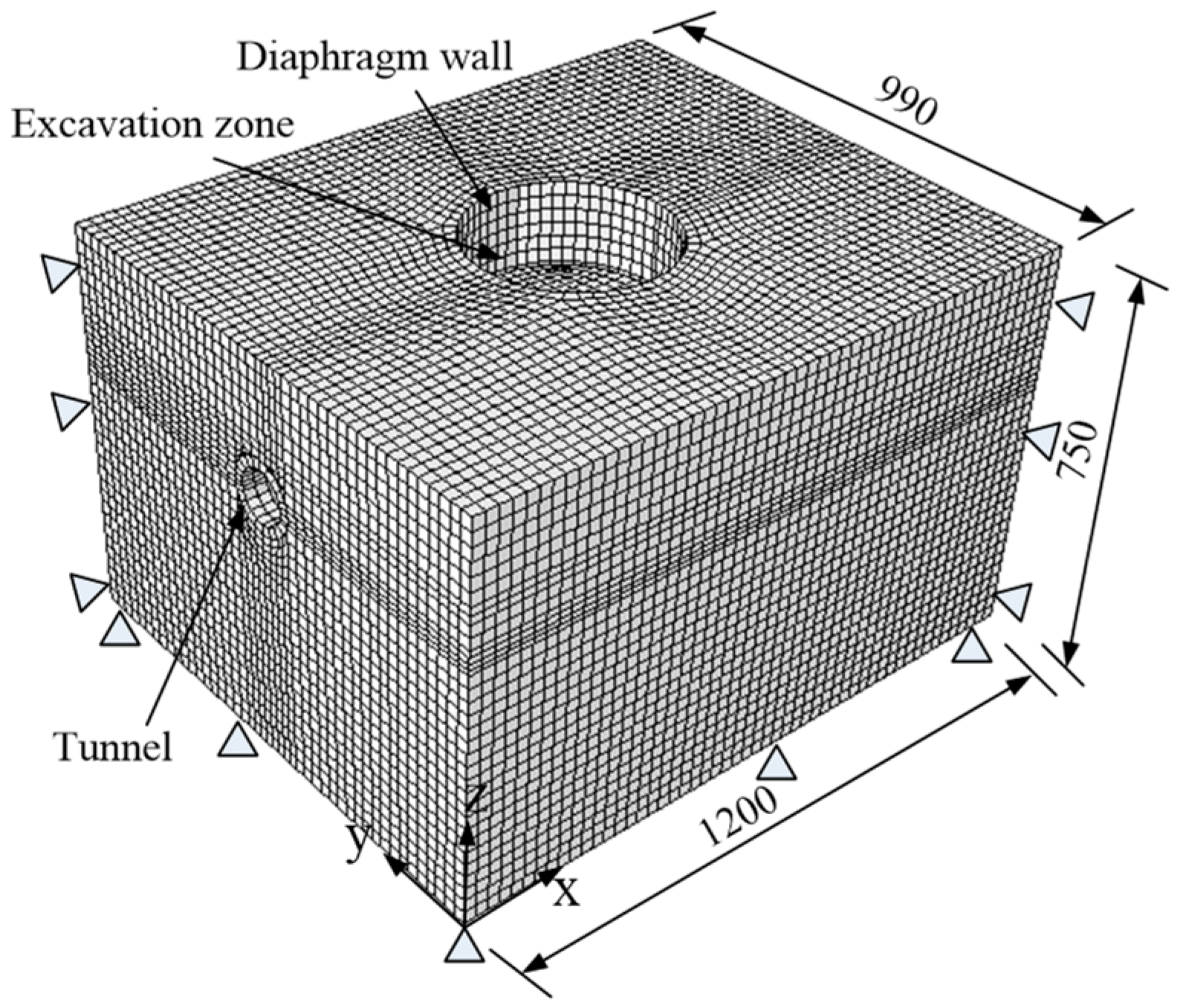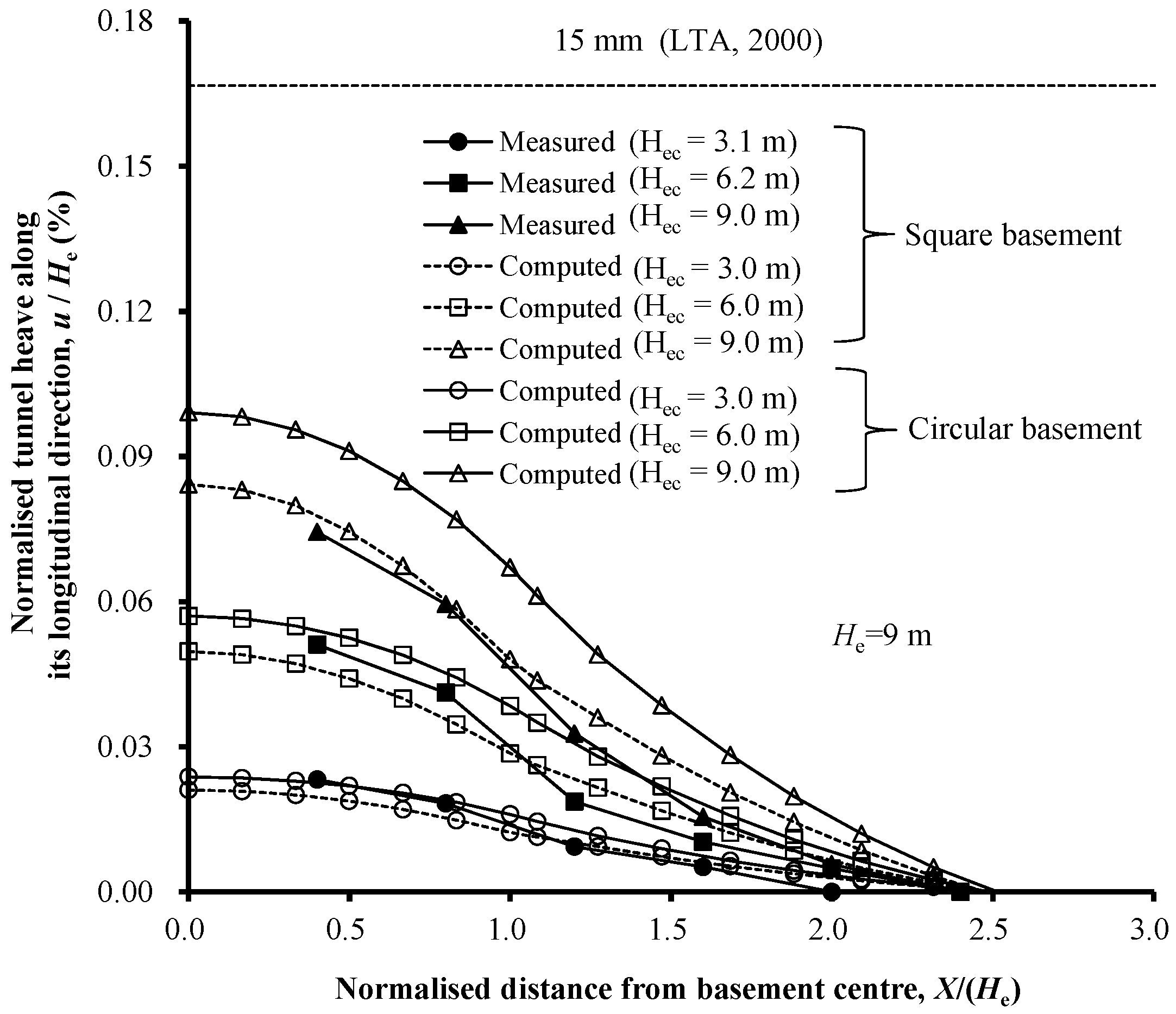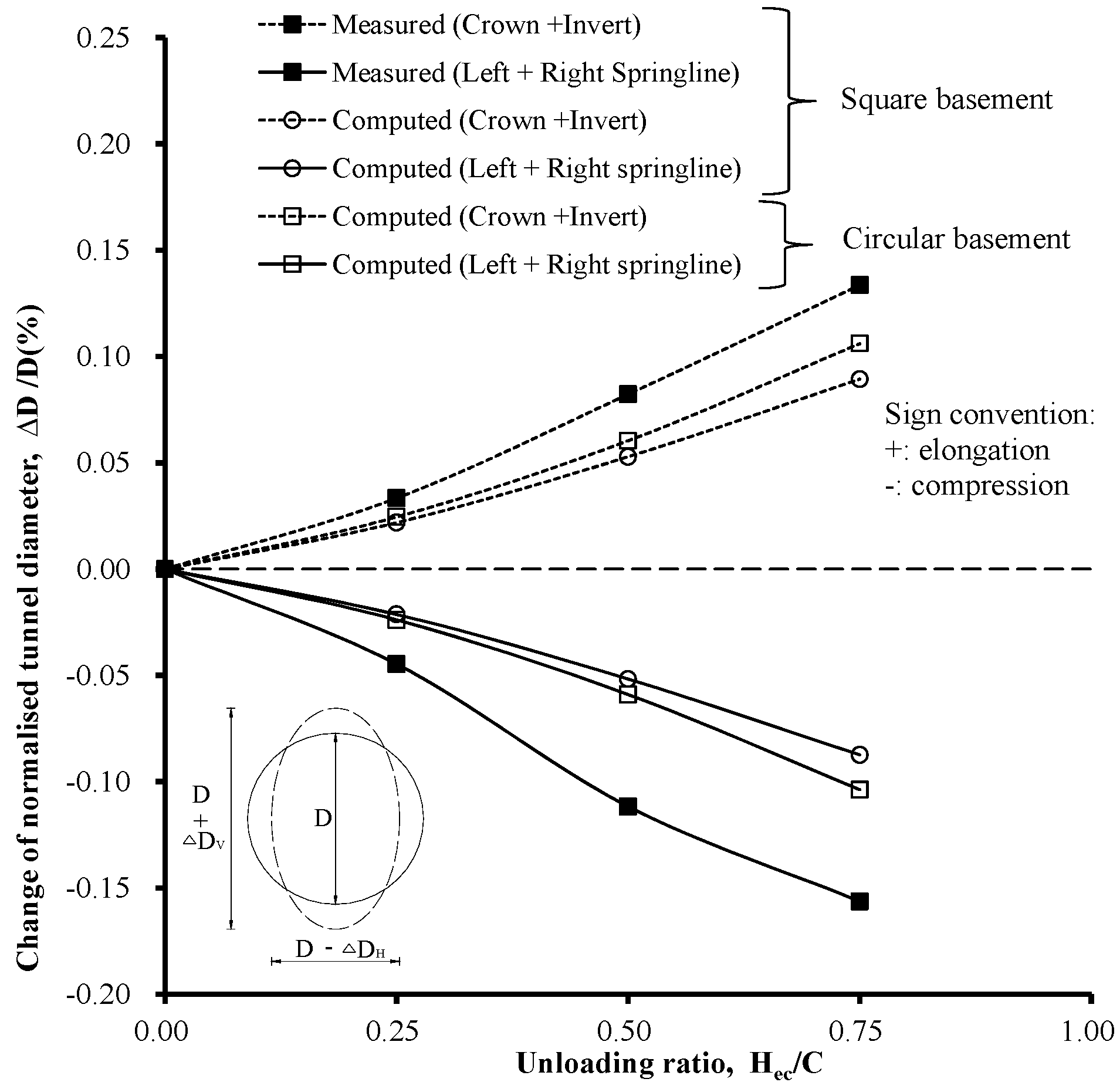A Precise Prediction of Tunnel Deformation Caused by Circular Foundation Pit Excavation
Abstract
1. Introduction
2. Introduction of a Centrifuge Model Test
3. Finite Element Model
3.1. Finite Element Mesh and Boundary Condition
3.2. Constitutive Model and Model Parameters
3.3. Numerical Modelling Procedures
- Establish the initial stress conditions using K0 = 0.5. Apply the same amounts of vertical and horizontal pressure as that in the centrifuge test to the formation level and diaphragm wall, respectively.
- Incrementally increase the gravitational acceleration of the whole model from 1 g to 60 g in four steps, i.e., from 1 g, to 15 g, to 30 g, to 45 g, and finally to 60 g. Simultaneously, apply pressure to the formation level and the wall.
- Decrease the amounts of vertical and horizontal pressure gradually in each excavation stage to simulate excavation until a depth of 9 m is reached.
4. Result Interpretation
4.1. Tunnel Heave in Longitudinal Direction
4.2. Stress Distribution around the Tunnel Lining
4.3. Tunnel Diameter Change
4.4. Bending Strain at the Tunnel Lining
5. Conclusions
- (a)
- Tunnel heave occurred in the existing tunnel lining, owing to stress relief above the existing tunnel. Thus, the tunnel heave caused by the circular basement excavation was 18% larger than that caused by the square basement.
- (b)
- The tunnel lining caused by both basement excavation types was elongated vertically and compressed horizontally with the basement excavation depth. The maximum tunnel diameter change caused by the circular basement excavation was 22% larger than that caused by the square basement excavation.
- (c)
- In the transverse direction, the compressive strains were recorded at the tunnel springlines, while the tensile strains arose at the other tunnel elements. The basement shape had little influence on the tunnel bending strain. In the tunnel’s longitudinal direction, the symmetrical bending strain distribution could be determined with regard to the basement excavation centerline. The computed maximum tunnel bending strain caused by the circular excavation was 32% smaller than that caused by the square excavation.
- (d)
- Under identical excavation area conditions, the extent of the influence of the stress relief caused by the circular excavation was wider and deeper than that caused by the square excavation. This implies that controlling the deformation of a metro tunnel under excavation depends mainly on the length of the metro tunnel passing through the excavation area, rather than on the excavation shape.
Data Availability Statement
Author Contributions
Funding
Acknowledgments
Conflicts of Interest
References
- Huang, X.; Schweiger, H.F.; Huang, H.W. Influence of deep excavations on nearby existing tunnels. Int. J. Geomech. 2013, 13, 170–180. [Google Scholar] [CrossRef]
- Shi, J.W.; Ng, C.W.; Chen, Y.H. Three-dimensional numerical parametric study of the influence of basement excavation on existing tunnel. Comput. Geotech. 2015, 63, 146–158. [Google Scholar] [CrossRef]
- Doležalová, M. Tunnel complex unloaded by a deep excavation. Comput. Geotech. 2001, 28, 469–493. [Google Scholar] [CrossRef]
- Sharma, J.S.; Hefny, A.M.; Zhao, J.; Chan, C.W. Effect of large excavation on displacement of adjacent MRT tunnels. Tunn. Undergr. Space Technol. 2001, 16, 93–98. [Google Scholar] [CrossRef]
- Zheng, G.; Wei, S.W. Numerical analysis of influence of overlying pit excavation on existing tunnels. J. Cent. South Univ. Technol. 2008, 15, 69–75. [Google Scholar] [CrossRef]
- Huang, X.; Huang, H.W.; Zhang, D.M. Centrifuge modeling of deep excavation over existing tunnels. Geotech. Eng. 2014, 167, 3–18. [Google Scholar] [CrossRef]
- Ng, C.W.; Shi, J.; Hong, Y. Three-dimensional centrifuge modelling of basement excavation effects on an existing tunnel in dry sand. Can. Geotech. J. 2013, 50, 874–888. [Google Scholar] [CrossRef]
- Hu, Z.F.; Yue, Z.Q.; Zhou, J.; Tham, L.G. Design and construction of a deep excavation in soft soils adjacent to the Shanghai Metro tunnels. Can. Geotech. J. 2003, 40, 933–948. [Google Scholar] [CrossRef]
- Gao, G.; Gao, M.; Yang, C. Influence of deep excavation on deformation of operating metro tunnels and countermeasures. Chin. J. Geotech. Eng. 2010, 32, 453–459. [Google Scholar]
- Zheng, G.; Du, Y.; Diao, Y. Optimization Analysis of Efficiency of Isolation Piles Incontrolling the Deformation of Existing Tunnels Adjacent to Deep Excavation. Chin. J. Rock Mech. Eng. 2015, 34, 3499–3509. [Google Scholar]
- Feng, S.J.; Gao, G.Y.; AI, H.T. Deformation analysis of group excavation adjacent to subway tunnels. Chin. J. Geotech. Eng. 2008, 30, 112–117. [Google Scholar]
- Ng, C.W.; Sun, H.S.; Lei, G.H.; Shi, J.W.; Mašín, D. Ability of three different soil constitutive models to predict a tunnel’s response to basement excavation. Can. Geotech. J. 2015, 52, 1685–1698. [Google Scholar] [CrossRef]
- Ng, C.W.; Shi, J.W.; David, M.; Sun, H.S.; Lei, G.H. Influence of sand density and retaining wall stiffness on three-dimensional responses of tunnel to basement excavation. Can. Geotech. J. 2015, 52, 1811–1829. [Google Scholar] [CrossRef]
- Zheng, G.; Du, Y.; Diao, Y. Influenced zones for deformation of existing tunnels adjacent to excavations. Chin. J. Geotech. Eng. 2016, 38, 599–612. [Google Scholar]
- Zhang, Z.G.; Huang, M.S.; Wang, W.D. Evaluation of deformation response for adjacent tunnels due to soil unloading in excavation engineering. Tunn. Undergr. Space Technol. 2013, 38, 244–253. [Google Scholar] [CrossRef]
- Zhang, J.F.; Chen, J.J.; Wang, J.H. Prediction of tunnel displacement induced by adjacent excavation in soft soil. Tunn. Undergr. Space Technol. 2013, 36, 24–33. [Google Scholar] [CrossRef]
- Shi, J.; Ng, C.W.; Chen, Y. A simplified method to estimate three-dimensional tunnel responses to basement excavation. Tunn. Undergr. Space Technol. 2017, 62, 53–63. [Google Scholar] [CrossRef]
- Zhou, J.J.; Rao, S.L. The design and construction of large mixed foundation in west anchorage of Humen Bridge. Bridge Constr. 1995, 2, 44–47. [Google Scholar]
- Liu, S.X. The design of circular diaphragm wall in the four phase of the project of Qinhuangdao port coal terminal dumper. Port Eng. Technol. 1995, 4, 28–35. [Google Scholar]
- Zhu, F. Monitoring and Analysis of a Deep Small Diameter Circular Excavation. Master’s Thesis, Shanghai Jiao Tong University, Shanghai, China, 2007. [Google Scholar]
- Zhang, Z.J.; Tang, Y.; Wang, J.H. Measured deformation of a semi-circular foundation pit in Shanghai soft soils. Chin. J. Geotech. Eng. 2014, 36, 451–454. [Google Scholar]
- Prater, E.G. An examination of some theories of earth pressure on shaft linings. Can. Geotech. J. 1977, 14, 91–106. [Google Scholar] [CrossRef]
- Dong, X.P.; Guo, Q.H.; Zhou, S.H. Character and factor analysis of deformation of diaphragm wall in the cylindrical foundation pit. Chin. J. Undergr. Space Eng. 2005, 4, 196–199. [Google Scholar]
- Liu, F.Q.; Wang, J.H. The active earth pressure of circular pit subjected to non-uniform surcharge loading. J. Shanghai Jiaotong Univ. 2006, 40, 2134–2136. [Google Scholar]
- Cheng, Y.M.; Au, S.K.; Hu, Y.Y.; Wei, W.B. Active pressure for circular cut with Berezantzev’s and Prater’s theories, numerical modeling and field measurements. Soils Found. 2008, 48, 621–631. [Google Scholar] [CrossRef]
- Tobar, T.; Meguid, M.A. Comparative evaluation of methods to determine the earth pressure distribution on cylindrical shafts: A review. Tunn. Undergr. Space Technol. 2010, 25, 188–197. [Google Scholar] [CrossRef]
- Kim, K.Y.; Lee, D.S.; Cho, J. The effect of arching pressure on a vertical circular shaft. Tunn. Undergr. Space Technol. 2013, 37, 10–21. [Google Scholar] [CrossRef]
- Liu, F.Q. Lateral earth pressures acting on circular retaining walls. Int. J. Geomech. 2014, 14, 613–624. [Google Scholar] [CrossRef]
- Meguid, M.A.; Tran, V.D.H.; Chouinard, L.E. Discrete element and experimental investigations of the earth pressure distribution on cylindrical shafts. Int. J. Geomech. 2014, 14, 80–91. [Google Scholar]
- Zhang, J.G.; Ren, P. Numerical simulation for constructionprocess of a very deep circular pit. In Proceedings of the International Conference on Transportation Engineering, Chengdu, China, 23–25 July 2011; pp. 1786–1791. [Google Scholar]
- ABAQUS, Inc. ABAQUS User’s and Theory Manuals; Version 6.17; ABAQUS, Inc.: Providence Rhode Island, RI, USA, 2017. [Google Scholar]
- Kolymbas, D. An outline of hypoplasticity. Arch. Appl. Mech. 1991, 61, 143–151. [Google Scholar]
- Gudehus, G. A comprehensive constitutive equation for granular materials. Soils Found. 1996, 36, 1–12. [Google Scholar] [CrossRef]
- Von Wolffersdorff, P.A. A hypoplastic relationship for granular material with a predefined limit state surface. Mech. Cohesive Frict. Mater. 1996, 1, 251–271. [Google Scholar] [CrossRef]
- Wu, W.; Bauer, E.; Kolymbas, D. Hypoplastic constitutive model with critical state for granular materials. Mechanics of Materials 1996, 23, 45–69. [Google Scholar] [CrossRef]
- Mašín, D. Hypoplastic Cam-clay model. Géotechnique 2012, 62, 549–553. [Google Scholar] [CrossRef]
- Mašín, D. Clay hypoplasticity with explicitly defined asymptotic states. Acta Geotech. 2013, 8, 481–496. [Google Scholar] [CrossRef]
- Mašín, D. Clay hypoplasticity model including stiffness anisotropy. Géotechnique 2014, 64, 232–238. [Google Scholar] [CrossRef]
- Gudehus, G.; Amorosi, A.; Gens, A.; Herle, I.; Kolymbas, D.; Mašín, D.; Muir Wood, D.; Niemunis, A.; Nova, R.; Pastor, M.; et al. The soilmodels.info project. Int. J. Numer. Anal. Methods Geomech. 2008, 32, 1571–1572. [Google Scholar] [CrossRef]
- Niemunis, A.; Herle, I. Hypoplastic model for cohensionless soils with elastic strain range. Mech. Cohesive Frict. Mater. 1997, 2, 279–299. [Google Scholar] [CrossRef]
- Herle, I.; Gudehus, G. Determination of parameters of a hypoplastic constitutive model from properties of grain assemblies. Mech. Cohesive Frict. Mater. 1999, 4, 461–486. [Google Scholar] [CrossRef]
- Maeda, K.; Miura, K. Confining stress dependency of mechanical properties of sands. Soils Found. 1999, 39, 53–67. [Google Scholar] [CrossRef]
- Iwasaki, T.; Tatsuoka, F.; Takagi, Y. Shear moduli of sands under cyclic torsional shear loading. Soils Found. 1978, 18, 39–50. [Google Scholar] [CrossRef]
- LTA. Code of Practice for Railway Protection; Development & Building Control Department, Land Transport Authority (LTA): Singapore, 2000. [Google Scholar]
- BD. Practice Note for Authorized Persons APP-24. In Technical Notes for Guidance in Assessing the Effects of Civil Engineering Construction/Building Development on Railway Structures and Operations; Building Department of the Government of HKSAR (BD): Hong Kong, China, 2009. [Google Scholar]
- British Tunnelling Society (BTS). Specification for Tunnelling; Thomas Telford: London, UK, 2000. [Google Scholar]
- American Concrete Institute. Control of Cracking in Concrete Structures (ACI 224R-01); American Concrete Institute: Farmington Hills, MI, USA, 2001. [Google Scholar]








| Soil Parameters | Values |
|---|---|
| Critical state friction angle (1), φc | 30° |
| Granulates hardness (1), hs | 2.6 GPa |
| Exponent n (1), n | 0.27 |
| Minimum void ratio at zero pressure (1), ed0 | 0.61 |
| Critical void ratio at zero pressure (1), ec0 | 0.98 |
| Maximum void ratio at zero pressure (1), ei0 | 1.10 |
| Exponent α (2), α | 0.14 |
| Exponent β (2), β | 3.0 |
| Parameter controlling the initial shear modulus upon a 180° strain path reversal and in the initial loading (2), mR | 5.5 |
| Parameter controlling the initial shear modulus upon a 90° strain path reversal (2), mT | 2.75 |
| Size of elastic range (2), R | 3 × 10−5 |
| Parameter controlling rate of degradation of stiffness with strain (2), βr | 0.08 |
| Parameter controlling rate of degradation of stiffness with strain (2), χ | 1.0 |
| Coefficient of at-rest earth pressure, K0 | 0.5 |
| Dry density, ρd | 1542 kg/m3 |
| Void ratio, e | 0.72 |
© 2019 by the authors. Licensee MDPI, Basel, Switzerland. This article is an open access article distributed under the terms and conditions of the Creative Commons Attribution (CC BY) license (http://creativecommons.org/licenses/by/4.0/).
Share and Cite
Sun, H.; Wang, L.; Chen, S.; Deng, H.; Zhang, J. A Precise Prediction of Tunnel Deformation Caused by Circular Foundation Pit Excavation. Appl. Sci. 2019, 9, 2275. https://doi.org/10.3390/app9112275
Sun H, Wang L, Chen S, Deng H, Zhang J. A Precise Prediction of Tunnel Deformation Caused by Circular Foundation Pit Excavation. Applied Sciences. 2019; 9(11):2275. https://doi.org/10.3390/app9112275
Chicago/Turabian StyleSun, Huasheng, Lingwei Wang, Shenwei Chen, Hengwei Deng, and Jihua Zhang. 2019. "A Precise Prediction of Tunnel Deformation Caused by Circular Foundation Pit Excavation" Applied Sciences 9, no. 11: 2275. https://doi.org/10.3390/app9112275
APA StyleSun, H., Wang, L., Chen, S., Deng, H., & Zhang, J. (2019). A Precise Prediction of Tunnel Deformation Caused by Circular Foundation Pit Excavation. Applied Sciences, 9(11), 2275. https://doi.org/10.3390/app9112275




